K. Lang-Slattery's Blog, page 4
April 16, 2021
Elderhostel and Agra Revisited (Part 2 of Return to India)
After 28 years, I was again in India. This time, rather than sharing a romantic adventure with my new husband, I was on an Elderhostel tour with my older sister, Una. I had reached the ripe age of 55, which at that time was the age the travel group considered elder-enough. Of course, younger travel partners were allowed to accompany their significant other, but Una and I both qualified on our own.
I had heard many great things about Elderhostel and I looked forward to the educational aspects of their program. But, it was my first time traveling with any type of tour-group and I felt a bit trepidatious about the group aspect of the trip. I needn’t have worried.
I discovered on this trip there was much to like about Elderhostel/Road Scholar programs. On five later trips with the organization, I have found the following to be generally the norm:
Average age of participants is around 65 or 70. The Road Scholar web-site currently says their travelers are “lifelong learners typically over the age of 50.”Some participants are Elderhostel devotees who have attended multiple programs.The ratio of women to men is about 2 to 1. Most of the male attendees are there with their wives. This is not the group to look for a romantic fling!The attendees are friendly, eager to learn, active, and non-complaining. Una and I tried to join a different group at each meal and to sit with different people each day on excursions.The guides are excellent, knowledgeable, and have good people-skills.“Lectures” by local specialists and experts are offered almost every day.Excursions are well-organized, use comfortable or exotic modes of transportation, and are always accompanied by a local guide who shares a depth of information and never seems to simply spout a memorized spiel.In India, besides bus and train, we rode in a tuk-tuk (a kind of motorcycle-powered taxi), in an army style jeep, in an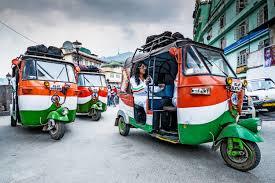 antique auto from a maharaja’s collection, on the back of an elephant, and in a pony-cart.The food is excellent and always includes both western and local options.The accommodations are no longer dorms or youth-hostels. We stayed at three- and four-star hotels. In India, some of the hotels were almost luxurious.Most tours are all-inclusive so there are no surprises financially.
antique auto from a maharaja’s collection, on the back of an elephant, and in a pony-cart.The food is excellent and always includes both western and local options.The accommodations are no longer dorms or youth-hostels. We stayed at three- and four-star hotels. In India, some of the hotels were almost luxurious.Most tours are all-inclusive so there are no surprises financially.Our tour, named “Northern India, Crossroad of the World,” began in earnest on the first day with a lecture on India’s path to independence presented by a Gandhi scholar. Soon enough, we were in a comfortable bus taking in the sights of Delhi. Our first stop was the Red Fort which Tom and I had visited years before. Though the fort remained impressive, I remembered it as more stunningly beautiful. Could it be that on my earlier visit, I looked at all things through the rosy lens of love and the adventure of a lifetime?
After two days in the capital, our group boarded a train and headed for Agra. I looked forward to seeing the Taj Mahal and Fatehpur Sikri again and hoped they would live up to the beauty of my memories. This turned out to be another unfounded worry. The day in Agra made me fall in love again—this time with Elderhostel.
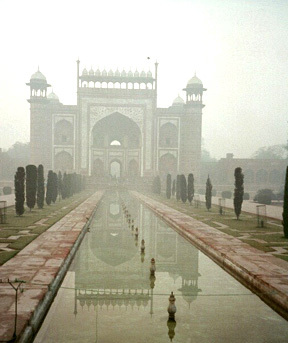 We were warned that if the weather report was good, we should be prepared for an early morning departure from the hotel. When the pre-dawn call came, we bundled up in sweaters, boarded our bus, and minutes later entered the Taj Mahal garden through the wooden gates. In the pale light, we stood near the entrance, rubbed our icy hands together to warm them, and waited. We peered into thick, gray mist and glimpsed the shrouded form of one of the most famous tombs in the world. Gradually the mist lifted and the golden glow of sunrise revealed the Taj Mahal in all its glory. The reflecting pool shone silver in the pale light, with gardens on either side. Between “ooohs” and “aahs,” we clicked our cameras and tried to capture the magical moment on film.
We were warned that if the weather report was good, we should be prepared for an early morning departure from the hotel. When the pre-dawn call came, we bundled up in sweaters, boarded our bus, and minutes later entered the Taj Mahal garden through the wooden gates. In the pale light, we stood near the entrance, rubbed our icy hands together to warm them, and waited. We peered into thick, gray mist and glimpsed the shrouded form of one of the most famous tombs in the world. Gradually the mist lifted and the golden glow of sunrise revealed the Taj Mahal in all its glory. The reflecting pool shone silver in the pale light, with gardens on either side. Between “ooohs” and “aahs,” we clicked our cameras and tried to capture the magical moment on film.
After viewing the gardens, we boarded the bus again and our guide promised that this was only the beginning. . . “The best will come this evening,” he promised with a broad grin. I was familiar with the places we saw during the day and, though as lovely as I remembered, none were as glorious as the Taj Mahal at sunrise. Then in the late afternoon, we all piled into seven, matching white, Morris Minor taxis.
Our string of small vehicles sped through the narrow alleys of old Agra, bumping and lurching over ruts and around trucks, tuk-tuks, cows, ox carts, and pedestrians. It felt like white-water rafting through humanity. We crossed the Jumna river on a narrow bridge, then headed across open fields to a village of low, thatched houses. The taxis slowed to a crawl in the dirt lanes of the village, honking at every turn and intersection. Finally, we stopped. Ahead stretched an expanse of hillocky, white sand, the river, and, on the other side, the Taj Mahal.
 Dusk approached as we walked across the sand. We passed women carrying water jugs on their heads, tall, tied bundles of reeds, and rows of seedling watermelon vines planted in the river sand. In the distance, on the far shore, smoke and flames rose up from the cremation grounds. The mingled scents of burning wood and river damp filled the air.
Dusk approached as we walked across the sand. We passed women carrying water jugs on their heads, tall, tied bundles of reeds, and rows of seedling watermelon vines planted in the river sand. In the distance, on the far shore, smoke and flames rose up from the cremation grounds. The mingled scents of burning wood and river damp filled the air.
At the water’s edge, we gazed across to the Taj, high on the far embankment. The white domes and minarets, gilded by the light of the setting sun, were reflected in the steel-blue water of the Jumna river. The color of the tomb shifted from gold to amber, from amber to mauve, and to the deep blue of evening. We wandered along the river bank as night descended and the heat of the day seeped out of the air. It was a truly extra-ordinary evening, more beautiful than anything I had ever seen, even during those romantic years when Tom and I traveled in a van.
white domes and minarets, gilded by the light of the setting sun, were reflected in the steel-blue water of the Jumna river. The color of the tomb shifted from gold to amber, from amber to mauve, and to the deep blue of evening. We wandered along the river bank as night descended and the heat of the day seeped out of the air. It was a truly extra-ordinary evening, more beautiful than anything I had ever seen, even during those romantic years when Tom and I traveled in a van.
Now I couldn’t wait to see what else Elderhostel had in store.
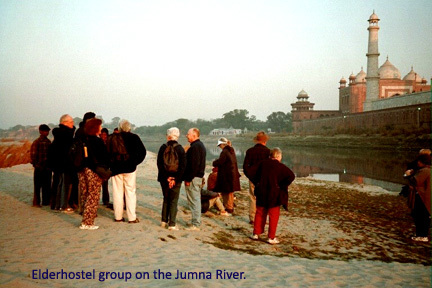
The post Elderhostel and Agra Revisited (Part 2 of Return to India) appeared first on Klang Slattery.
Elderhostel and Agra Revisited
After 28 years, I was again in India. This time, rather than sharing a romantic adventure with my new husband, I was on an Elderhostel tour with my older sister, Una. I had reached the ripe age of 55, which at that time was the age the travel group considered elder-enough. Of course, younger travel partners were allowed to accompany their significant other, but Una and I both qualified on our own.
I had heard many great things about Elderhostel and I looked forward to the educational aspects of their program. But, it was my first time traveling with any type of tour-group and I felt a bit trepidatious about the group aspect of the trip. I needn’t have worried.
I discovered on this trip there was much to like about Elderhostel/Road Scholar programs. On five later trips with the organization, I have found the following to be generally the norm:
Average age of participants is around 65 or 70. The Road Scholar web-site currently says their travelers are “lifelong learners typically over the age of 50.”Some participants are Elderhostel devotees who have attended multiple programs.The ratio of women to men is about 2 to 1. Most of the male attendees are there with their wives. This is not the group to look for a romantic fling!The attendees are friendly, eager to learn, active, and non-complaining. Una and I tried to join a different group at each meal and to sit with different people each day on excursions.The guides are excellent, knowledgeable, and have good people-skills.“Lectures” by local specialists and experts are offered almost every day.Excursions are well-organized, use comfortable or exotic modes of transportation, and are always accompanied by a local guide who shares a depth of information and never seems to simply spout a memorized spiel.In India, besides bus and train, we rode in a tuk-tuk (a kind of motorcycle-powered taxi), in an army style jeep, in an antique auto from a maharaja’s collection, on the back of an elephant, and in a pony-cart.The food is excellent and always includes both western and local options.The accommodations are no longer dorms or youth-hostels. We stayed at three- and four-star hotels. In India, some of the hotels were almost luxurious.Most tours are all-inclusive so there are no surprises financially.
antique auto from a maharaja’s collection, on the back of an elephant, and in a pony-cart.The food is excellent and always includes both western and local options.The accommodations are no longer dorms or youth-hostels. We stayed at three- and four-star hotels. In India, some of the hotels were almost luxurious.Most tours are all-inclusive so there are no surprises financially.Our tour, named “Northern India, Crossroad of the World,” began in earnest on the first day with a lecture on India’s path to independence presented by a Gandhi scholar. Soon enough, we were in a comfortable bus taking in the sights of Delhi. Our first stop was the Red Fort which Tom and I had visited years before. Though the fort remained impressive, I remembered it as more stunningly beautiful. Could it be that on my earlier visit, I looked at all things through the rosy lens of love and the adventure of a lifetime?
After two days in the capital, our group boarded a train and headed for Agra. I looked forward to seeing the Taj Mahal and Fatehpur Sikri again and hoped they would live up to the beauty of my memories. This turned out to be another unfounded worry. The day in Agra made me fall in love again—this time with Elderhostel.
 We were warned that if the weather report was good, we should be prepared for an early morning departure from the hotel. When the pre-dawn call came, we bundled up in sweaters, boarded our bus, and minutes later entered the Taj Mahal garden through the wooden gates. In the pale light, we stood near the entrance, rubbed our icy hands together to warm them, and waited. We peered into thick, gray mist and glimpsed the shrouded form of one of the most famous tombs in the world. Gradually the mist lifted and the golden glow of sunrise revealed the Taj Mahal in all its glory. The reflecting pool shone silver in the pale light, with gardens on either side. Between “ooohs” and “aahs,” we clicked our cameras and tried to capture the magical moment on film.
We were warned that if the weather report was good, we should be prepared for an early morning departure from the hotel. When the pre-dawn call came, we bundled up in sweaters, boarded our bus, and minutes later entered the Taj Mahal garden through the wooden gates. In the pale light, we stood near the entrance, rubbed our icy hands together to warm them, and waited. We peered into thick, gray mist and glimpsed the shrouded form of one of the most famous tombs in the world. Gradually the mist lifted and the golden glow of sunrise revealed the Taj Mahal in all its glory. The reflecting pool shone silver in the pale light, with gardens on either side. Between “ooohs” and “aahs,” we clicked our cameras and tried to capture the magical moment on film.
After viewing the gardens, we boarded the bus again and our guide promised that this was only the beginning. . . “The best will come this evening,” he promised with a broad grin. I was familiar with the places we saw during the day and, though as lovely as I remembered, none were as glorious as the Taj Mahal at sunrise. Then in the late afternoon, we all piled into seven, matching white, Morris Minor taxis.
Our string of small vehicles sped through the narrow alleys of old Agra, bumping and lurching over ruts and around trucks, tuk-tuks, cows, ox carts, and pedestrians. It felt like white-water rafting through humanity. We crossed the Jumna river on a narrow bridge, then headed across open fields to a village of low, thatched houses. The taxis slowed to a crawl in the dirt lanes of the village, honking at every turn and intersection. Finally, we stopped. Ahead stretched an expanse of hillocky, white sand, the river, and, on the other side, the Taj Mahal.
 Dusk approached as we walked across the sand. We passed women carrying water jugs on their heads, tall, tied bundles of reeds, and rows of seedling watermelon vines planted in the river sand. In the distance, on the far shore, smoke and flames rose up from the cremation grounds. The mingled scents of burning wood and river damp filled the air.
Dusk approached as we walked across the sand. We passed women carrying water jugs on their heads, tall, tied bundles of reeds, and rows of seedling watermelon vines planted in the river sand. In the distance, on the far shore, smoke and flames rose up from the cremation grounds. The mingled scents of burning wood and river damp filled the air.
At the water’s edge, we gazed across to the Taj, high on the far embankment. The white domes and minarets, gilded by the light of the setting sun, were reflected in the steel-blue water of the Jumna river. The color of the tomb shifted from gold to amber, from amber to mauve, and to the deep blue of evening. We wandered along the river bank as night descended and the heat of the day seeped out of the air. It was a truly extra-ordinary evening, more beautiful than anything I had ever seen, even during those romantic years when Tom and I traveled in a van.
white domes and minarets, gilded by the light of the setting sun, were reflected in the steel-blue water of the Jumna river. The color of the tomb shifted from gold to amber, from amber to mauve, and to the deep blue of evening. We wandered along the river bank as night descended and the heat of the day seeped out of the air. It was a truly extra-ordinary evening, more beautiful than anything I had ever seen, even during those romantic years when Tom and I traveled in a van.
Now I couldn’t wait to see what else Elderhostel had in store.

The post Elderhostel and Agra Revisited appeared first on Klang Slattery.
March 31, 2021
A Night in Delhi (Part 1 of Return to India)
“We need to head straight for Delhi,” Tom said. “I want to get you to a doctor.” I simply groaned. I didn’t want to miss Rajasthan, our next planned stop, but I was miserable and scared. (page 281, Wherever the Road Leads)
This illness in early March of 1973, set the stage for my return to India in the winter of 2001. Twenty-eight years after the trip described in Wherever the Road Leads, I would finally see Rajasthan.
Several months before, my older sister mentioned to me that she wanted to visit India, but none of her friends were interested in traveling to such an exotic location. “Well, I’ll go,” I responded. “As long as we can go to Rajasthan and to Pune to visit the Girl Scout World Center.”
Soon Una and I were making plans. We would travel with Elderhostel (now called Road Scholar) for two weeks, then plunge into India on our own for an additional week. Because we would both travel using Frequent Flyer miles, we had to take different flights and would arrive at different times. We would meet in New Delhi at the hotel designated by our tour group.
Thus, on January 14, 2001 after more than 24-hours travel, I landed at the old Indira Gandhi International Airport. What a contrast from the beautiful, new Changi Airport in Singapore where I had enjoyed a four hour lay-over. Changi had soothed me with delightful shops, WiFi, orchid gardens, a meal of satay, and a shower at the immaculate transit hotel.
Now, at ten o’clock at night, I found myself alone in an airport that couldn’t have been more different. Indira Gandhi International was dirty, noisy, crowded, confusing, and seemed to shout, “I am India. Remember me?” The tour representative who was supposed to meet me did not appear waving a placard showing my name. I would have to get to the hotel on my own.
I shouldered my heavy backpack and trundled to an office that displayed a sign reading, “Pre-paid taxis.” A tall, handsome Sikh stood behind the desk. I was reassured by his distinctive turban and neatly groomed beard, Sikh characteristics I had learned to trust back in 1973. He nodded and smiled broadly as he read the name of my hotel from the tour information and took my money. Then he waved me toward the exit door and indicated he would meet me outside.
Thankfully, he appeared again on the busy sidewalk crowded with touts waiting to accost tourists and offer them the best deal in town. He waved me toward a small, open, jeep-like vehicle at the front of the line of taxis. A slight, dark Indian with a woolen scarf wound around his neck waited nearby. This man loaded my bulky pack into the back of the jeep. Then another man appeared and jumped into the driver’s seat. As my Sikh helped me into the cramped back seat, he leaned over and spoke softly. “Will you give me something as I’m your porter?” Pretending not to hear, I clearly repeated the name of the hotel several times. All three men nodded and smiled, the Sikh gave the driver directions, and we were off!
Once we left the terminal, the two-lane road became totally dark, devoid of street-lights or buildings, though still crowded with small black cars, a few white luxury sedans, jitneys, and huge trucks. We zipped along, often squeezing between lumbering trucks and the center divider of dinged and broken concrete. The driver gleefully beeped his horn each time we began and succeeded at this maneuver.
In the intermittent glare of passing headlamps, I studied my driver. Neatly dressed, slender, with greased, combed back hair, and a well-trimmed mustache, he seemed friendly and curious in a way I knew to be typical. He asked if I was traveling alone, if I was single, and if my hotel was expensive. Beyond that, he concentrated on his driving.
After a while the traffic thinned and nothing could be seen along the road. Black night stretched out on both sides. Far in the distance, a few pin-points of light glinted. There was nothing to suggest we were approaching a city. If I had not been familiar with the roads of India, I’m sure I would have been terrified. Even so, I couldn’t help but think that I might soon find myself roughly deposited in the middle of a field, stripped of my luggage and my money, and left alone in the dark countryside. I clung to my seat, tried not to panic, and peered out the glass-less window.
We passed an army base, a Navy installation (very strange so far from any body of water), a few shops selling tandoori chickens and Bengali sweets, and occasional venders who pushed their carts as they headed home at the end of a long day. Gradually, the shops and the traffic began to increase again. Now, rather than trucks, the road filled with bicycles, bicycle rickshaws, and motor-scooters. The familiar sight of a helmeted, motor-scooter driver with a female passenger riding side-saddle on the rear brought back pleasant memories. The lady clung to her companion’s waist. As they passed, the folds of her sari flowed with the air currents.
We drove near a rubble strewn construction site where a row of tall piers of re-bar and concrete reached into the black night sky. My driver pointed at the tall structures and said with a touch of pride, “Metro train.” I reasoned that a new metro train would only be built leading to Delhi so we must be heading toward town. Perhaps I had escaped being kidnapped and stripped of my possessions.
We had been driving for a long time, yet the road remained dark and lined with non-descript, window-less walls. I wondered when I would begin to see hotels or a business district. Finally, the driver slowed down, pulled his jeep to the far left and waited for traffic to pass. Across the street, I saw one light, an old wall with a wide gate, and behind it, a white building. My driver found a gap in the traffic and drove through the gate into a paved courtyard. On one side of the courtyard, a man and a young woman, both elegantly dressed and draped in flower garlands, stood on a platform surrounded by a crowd of well-wishers. On the other side of the courtyard, a wide stairway led up to open doors that overflowed with light and the sounds of music. It seemed I had arrived.
I tipped my driver, adding more when he asked, and entered a wood-paneled lobby. What a relief to find a desk clerk who spoke fluent English and, best of all, had my name in his ledger! He showed me to a large room with a huge bed, a desk, a wooden wardrobe, a lumpy couch, and a spacious, tiled bathroom with an ample, old-fashioned tub.
It was after mid-night and I was exhausted. I settled on the bed and reached for the phone to order tea from room service. My tired hand nudged the bedside lamp, which produced a shower of sparks. An instant later, all the lights near the bed and in the bathroom went black. I leaned back against the pillow and sighed. I was indeed in India for a second adventure! But it seemed that electrical problems were to be expected whether one traveled in a Volkswagen van or stayed in a hotel.

The post A Night in Delhi (Part 1 of Return to India) appeared first on Klang Slattery.
A Night in Delhi
“We need to head straight for Delhi,” Tom said. “I want to get you to a doctor.” I simply groaned. I didn’t want to miss Rajasthan, our next planned stop, but I was miserable and scared. (page 281, Wherever the Road Leads)
This illness in early March of 1973, set the stage for my return to India in the winter of 2001. Twenty-eight years after the trip described in Wherever the Road Leads, I would finally see Rajasthan.
Several months before, my older sister mentioned to me that she wanted to visit India, but none of her friends were interested in traveling to such an exotic location. “Well, I’ll go,” I responded. “As long as we can go to Rajasthan and to Pune to visit the Girl Scout World Center.”
Soon Una and I were making plans. We would travel with Elderhostel (now called Road Scholar) for two weeks, then plunge into India on our own for an additional week. Because we would both travel using Frequent Flyer miles, we had to take different flights and would arrive at different times. We would meet in New Delhi at the hotel designated by our tour group.
Thus, on January 14, 2001 after more than 24-hours travel, I landed at the old Indira Gandhi International Airport. What a contrast from the beautiful, new Changi Airport in Singapore where I had enjoyed a four hour lay-over. Changi had soothed me with delightful shops, WiFi, orchid gardens, a meal of satay, and a shower at the immaculate transit hotel.
Now, at ten o’clock at night, I found myself alone in an airport that couldn’t have been more different. Indira Gandhi International was dirty, noisy, crowded, confusing, and seemed to shout, “I am India. Remember me?” The tour representative who was supposed to meet me did not appear waving a placard showing my name. I would have to get to the hotel on my own.
I shouldered my heavy backpack and trundled to an office that displayed a sign reading, “Pre-paid taxis.” A tall, handsome Sikh stood behind the desk. I was reassured by his distinctive turban and neatly groomed beard, Sikh characteristics I had learned to trust back in 1973. He nodded and smiled broadly as he read the name of my hotel from the tour information and took my money. Then he waved me toward the exit door and indicated he would meet me outside.
Thankfully, he appeared again on the busy sidewalk crowded with touts waiting to accost tourists and offer them the best deal in town. He waved me toward a small, open, jeep-like vehicle at the front of the line of taxis. A slight, dark Indian with a woolen scarf wound around his neck waited nearby. This man loaded my bulky pack into the back of the jeep. Then another man appeared and jumped into the driver’s seat. As my Sikh helped me into the cramped back seat, he leaned over and spoke softly. “Will you give me something as I’m your porter?” Pretending not to hear, I clearly repeated the name of the hotel several times. All three men nodded and smiled, the Sikh gave the driver directions, and we were off!
Once we left the terminal, the two-lane road became totally dark, devoid of street-lights or buildings, though still crowded with small black cars, a few white luxury sedans, jitneys, and huge trucks. We zipped along, often squeezing between lumbering trucks and the center divider of dinged and broken concrete. The driver gleefully beeped his horn each time we began and succeeded at this maneuver.
In the intermittent glare of passing headlamps, I studied my driver. Neatly dressed, slender, with greased, combed back hair, and a well-trimmed mustache, he seemed friendly and curious in a way I knew to be typical. He asked if I was traveling alone, if I was single, and if my hotel was expensive. Beyond that, he concentrated on his driving.
After a while the traffic thinned and nothing could be seen along the road. Black night stretched out on both sides. Far in the distance, a few pin-points of light glinted. There was nothing to suggest we were approaching a city. If I had not been familiar with the roads of India, I’m sure I would have been terrified. Even so, I couldn’t help but think that I might soon find myself roughly deposited in the middle of a field, stripped of my luggage and my money, and left alone in the dark countryside. I clung to my seat, tried not to panic, and peered out the glass-less window.
We passed an army base, a Navy installation (very strange so far from any body of water), a few shops selling tandoori chickens and Bengali sweets, and occasional venders who pushed their carts as they headed home at the end of a long day. Gradually, the shops and the traffic began to increase again. Now, rather than trucks, the road filled with bicycles, bicycle rickshaws, and motor-scooters. The familiar sight of a helmeted, motor-scooter driver with a female passenger riding side-saddle on the rear brought back pleasant memories. The lady clung to her companion’s waist. As they passed, the folds of her sari flowed with the air currents.
We drove near a rubble strewn construction site where a row of tall piers of re-bar and concrete reached into the black night sky. My driver pointed at the tall structures and said with a touch of pride, “Metro train.” I reasoned that a new metro train would only be built leading to Delhi so we must be heading toward town. Perhaps I had escaped being kidnapped and stripped of my possessions.
We had been driving for a long time, yet the road remained dark and lined with non-descript, window-less walls. I wondered when I would begin to see hotels or a business district. Finally, the driver slowed down, pulled his jeep to the far left and waited for traffic to pass. Across the street, I saw one light, an old wall with a wide gate, and behind it, a white building. My driver found a gap in the traffic and drove through the gate into a paved courtyard. On one side of the courtyard, a man and a young woman, both elegantly dressed and draped in flower garlands, stood on a platform surrounded by a crowd of well-wishers. On the other side of the courtyard, a wide stairway led up to open doors that overflowed with light and the sounds of music. It seemed I had arrived.
I tipped my driver, adding more when he asked, and entered a wood-paneled lobby. What a relief to find a desk clerk who spoke fluent English and, best of all, had my name in his ledger! He showed me to a large room with a huge bed, a desk, a wooden wardrobe, a lumpy couch, and a spacious, tiled bathroom with an ample, old-fashioned tub.
It was after mid-night and I was exhausted. I settled on the bed and reached for the phone to order tea from room service. My tired hand nudged the bedside lamp, which produced a shower of sparks. An instant later, all the lights near the bed and in the bathroom went black. I leaned back against the pillow and sighed. I was indeed in India for a second adventure! But it seemed that electrical problems were to be expected whether one traveled in a Volkswagen van or stayed in a hotel.

The post A Night in Delhi appeared first on Klang Slattery.
March 4, 2021
A Young Woman on the Hippie Trail
Diane was barely twenty-one when she began her adventure. Raised in a middle-class family in Colorado, she felt lucky to be attending Stanford University as a pre-med student. However, by her Junior year she realized she didn’t want to be a surgeon as she had always thought. Suddenly unsure what she wanted to do with her life, Diane was determined to travel while she figured it out. Stanford offered a study abroad program than included transportation so Diane traveled to Florence, Italy, to complete her final term.
Diane told me of her disillusionment with the state of the world in the mid-70s. She was deeply affected by the murders of Martin Luther King, Robert Kennedy Jr. and the Nixon debacle. It seemed that nobody in leadership knew what to do. Inspired by James Michener’s novel, The Drifters, Diane decided she needed to figure it out for herself by seeing the world.
Starting in Italy right after graduation, she began her travels. A Stanford/Hewlett Packard connection in Singapore offered a possible job. She also had friends in Greece and India. These connections gave her a rough itinerary.
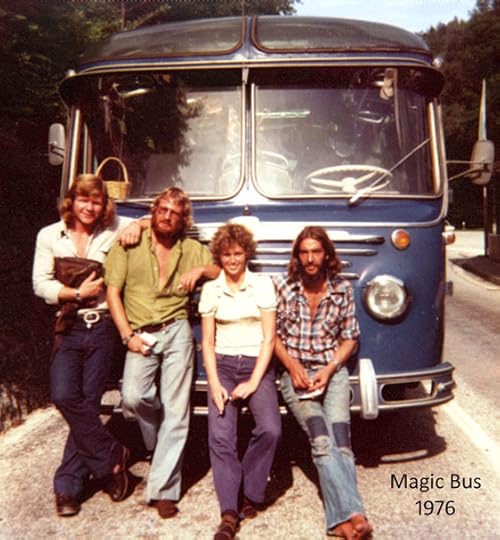
After visiting her friend in Greece, Diane headed for Istanbul, the starting point of most overland journeys. The Turkish city was a hub for young travelers who shared information and travel tips. There she learned about the Magic Bus, a transportation company that offered no-frills, cheap, rapid, and direct transportation to India. The other passengers turned out to be mainly drug-influenced hippies, and Diane soon realized she was uncomfortable traveling with this group. In Erzurum, a city in the middle of the great expanses of Eastern Turkey, Diane left the bus accompanied by a young man who was also uneasy with the other Magic Bus travelers. These two continued together for several weeks, but split when they arrived in Tehran.
Diane says she was surprised to find she fared better as a single woman traveling alone. She told me that the Middle-Eastern male perspective seemed to deduce that any woman who traveled with a male companion not her family or husband was sexually promiscuous. She experienced unwanted touching, rude remarks, and attempts to get her alone. Later when she traveled through eastern Iran and Afghanistan on her own, she felt she was viewed with awe, respect, even fear. “They treated me like a goddess,” she said.
Being a lone, woman traveler who hitchhiked, walked, and took local buses certainly exposed her to unbelievable experiences. It invited interaction with local people on a more intimate level than Tom and I could dream of when traveling in our own vehicle. As she walked from the Iran/Afghanistan border to Herat, Diane met a teacher who spoke English and took her under his wing. Soon she found herself working as the English tutor for the four daughters of an important local business man. She spent a month in Herat, teaching, living in the women’s world “behind the walls,” and walking freely about the city. Later, Diane met an American woman living in Kabul who raised Arabian horses. Her new friend invited her to come along on a horse-back riding trip into the Peshawar Valley.
Diane continued by public bus across the Khyber Pass, through Pakistan, and into India. In Delhi, she met up with the relatives a Sikh engineer she had known in Denver. Her days in Northern India were a delight, mainly due to the exceptional hospitality of this man’s family. They took her to see all the major sights and introduced her to the Sikh culture. Later, she traveled on her own to Southern India where she studied yoga under a well-known yoga master.

Having heard of its druggie reputation, Diane avoided Goa. Still, like Tom and me, the theft of personal documents brought her idyllic stay in Southern India to an end. “A blond, German woman stole my passport and all my money,” she said. “Amazingly, the villagers where I was staying took a collection to buy me a train ticket to Delhi.” As soon as she had her replacement passport, she headed home.
Diane’s experiences, some distressing and others unbelievably wonderful, changed her life. Like many other overland travelers, she returned with a heightened appreciation and acceptance of other people regardless of race, religion, health condition, or social status.
One of the most life-changing results of Diane’s year and a half adventure was that she could now let go of previous plans and simply let her life unfold. This was the understanding that she had set out to find.
The post A Young Woman on the Hippie Trail appeared first on Klang Slattery.
February 17, 2021
Hippie Trail Adventures
According to Wikipedia, the Hippie Trail is the name given to the overland journey from Europe to India and Nepal taken by travelers between the mid-1950s and the late 1970s.
Some weeks ago, a friend phoned to let me know that she was watching a webinar “about the road you wrote about in your memoir.” Though I was unable to join the online event, I did order and read the book written by the presenter, Sharif Gemie, a historian of contemporary culture.
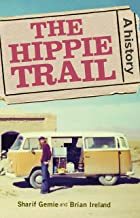
Based on interviews and self-published works, The Hippie Trail, A History by Sharif Gemie and Brian Ireland, is described as the first history of the Hippie Trail. “It records the joys and pains of budget travel to Kathmandu, India, and Afghanistan . . . in the 1960s and 1970s.” Dense with facts and analysis of trends, this book was fascinating in spite of its academic style. Many of the quotes, taken from oral histories and personal memoirs, reminded me of my own days on the trail.
One of the key elements of the trail was the idea of travelling as cheaply as possible. For Tom and me that meant a budget of $10 a day to include everything from food to gas to car repairs to souvenirs. We never stayed in a hotel and almost always cooked and ate in our van.
For many, cheap travel meant taking local transportation or hitch-hiking. Others paid for a ticket on one of the overland bus tours that plied the route. These companies (like Indiaman and Penn Overland) provided basic transportation along a planned itinerary. Sleeping arrangements ranged from reclining seats to tents, from bunks in the bus to scheduled stops at third-rate hotels and guest houses. As the authors state in The Hippie Trail, the trip was often an “epic struggle concerned {with} the maintenance of an aging coach across thousands of miles of rough roads, dodgy towns, dangerous mountain passes, and barren deserts.” These overland bus trips usually took about a month to get from Istanbul to Kathmandu.
Many independent travelers, like Tom and me (see my memoir at https://www.amazon.com/Wherever-Road-Leads-Memoir-Travel/dp/1734279648), drove their own vehicles, mainly Land Rovers or VW vans, all the way to India and back. In spite of the ever-present possibility of mechanical problems, this mode of travel allowed for more personal control, flexibility, and comfort.
What kind of travelers chose this exotic adventure? My memories match the research presented by Gemie and Ireland. We came mainly from England, North America, and Australia, but there were also travelers from throughout western Europe, especially Scandinavia, France, and Germany. We were mostly young. Tom and I, in our late twenties, were older than most. But we sometimes encountered older couples and families like our Danish friends who were in their middle years with teenage children.
Many of the youthful travelers were iconic hippies with long hair, fringes, and beads. They searched for drugs, enlightenment, and free love on the beaches of Goa. Travelers like us simply wanted to see the world and experience different cultures. We took great pains to not look like hippies, especially at border crossings. One thing I believe we all had in common was a desire to experience places and people in a more intimate way than standard tourism allowed. There were even a few true adventurers, like the Kunst brothers who walked around the world with a mule.
The heyday of the Hippie Trail occurred at a time when many young people were turned-off by the traditional life-style modeled by their parents. It also coincided with the Vietnam war when anti-war politics were rampant. And it was war that ended safe and easy access to the trail. In 1979, the Hippie Trail received a double-whammy: the Soviet invasion of Afghanistan and the Iranian Revolution. Since then, there has not been a time when the entire length of the trail, from Istanbul to India, has been safe.
Those of us who were lucky to travel the trail and see Eastern cultures up close, almost always came home with more inclusive ideas, totally changed by our experiences. And many became travel addicts like myself.
Did you or anyone you know travel the Hippie Trail between 1955 and 1979? If so, I’d love to hear from you. Please contact me and share your story.
To learn more:
The Hippie Trail: a History , by Dr. Sharif Gamie and Dr. Brian Ireland. https://www.amazon.com/Hippie-Trail-History-Sharif-Gemie/dp/1526114623YouTube.com: search “Hippie Trail” for several interesting videos.
The post Hippie Trail Adventures appeared first on Klang Slattery.
January 17, 2021
A Reading Challenge for Travel Lovers
I have been aware of book-reading challenges for some time but I never thought I would join one. My own bookshelves offer enough of a challenge. I am a book buying addict and my shelves overflow with books waiting to be read.
I love used book stores, Friends of the Library shops, and most of all, the shelves of college bookstores in the English literature section. I have a weakness for YA fiction because of its edginess and always check out those shelves in bookstores. Even the neighborhood Little Free Library across the street from my home occasionally offers up treasures. My Kindle library is almost as full as my actual book shelves. During the “stay at home days” of 2020, I, like many, read more than ever and made inroads into my stacks of unread books. And I have to admit I bought a few new books too.
The question of what 2021 will bring still lies behind a question mark. For me, keeping busy and reading are the best stress reducers. The work of publishing my memoir, Wherever the Road Leads, is done, but there is still publicity and marketing to occupy me. I spend hours perusing the internet, checking out sites that deal with van-life, travel, memoir, and reading. That’s how I stumbled onto The Book Girls’ Guide, 2021 Reading Challenge, Book Voyage: Read Around the World. Led by two women friends, Angela and Melissa, Book Girls’ Guide –, brings an obvious love of reading to its followers.
Of course, the title of this particular reading challenge is what caught my eye. Perhaps it would offer a place to share information about my book. When I checked the details, I was thrilled. This challenge was perfect for me and for my book.
The Book Voyage challenge divides the world into segments, based on geography and cultural differences. I’m sure it was a tricky job, with no perfect way to do it. Continents are divided sensibly and the inclusion of “Islands” and “Multiple Continents” brought the options to the twelve needed to have one per month. January is dedicated to books about the Arctic and the Antarctic. In February participants will read books that feature western Europe, and so on.
Best of all, the suggested book list is high quality and varied. The list of 20 books includes a classic (Call of the Wild, by Jack London) and the highly acclaimed new novel, Migrations, by Charlotte McConaghy. Fiction and non-fiction, memoir and mystery, comedy and romance, historical and contemporary – there is a book that will appeal to almost any reader. Challenge participants can also read books not on the list (perhaps one from their own stacks of waiting books) and they are encouraged to suggest other titles that fit the designated category.

To add to the fun, Angela and Melissa, supply a free printable tracker where readers can chart their choices on a colorful world map. There is also a Facebook group and an Instagram account associated with the Book Voyage challenge.
Totally impressed with The Book Girls’ Book Voyage, I signed up for my first official reading challenge. I started with Migrations a few days ago and I am already half-way through it. I’m looking forward to sharing the titles of some of my favorite books in the months ahead. And, without a doubt, I will be suggesting Wherever the Road Leads for next December when books that span multiple continents will be featured.
If all this sounds like fun, check it out. I’d love to have some of my readers join me. After a year of travel restrictions and with months yet to go before we can safely travel the world, this book challenge should help appease our unsatisfied wanderlust.
Read with the Book Girls | FacebookBook Girls’ Guide (@readwiththebookgirls) • Instagram photos and videosBook Girls’ Guide –The post A Reading Challenge for Travel Lovers appeared first on Klang Slattery.
January 3, 2021
Resolutions
Happy New Year! Have you made a 2021 resolution?
Years ago, I swore I would never again waste my resolution on “losing weight.” Though I usually succeeded with a dozen pounds or more in the short term, by the time January rolled around again, the efforts I had made would be buried under the joys of eating and drinking. That old “lose weight” goal was both self-perpetuating and boring! I am no slimmer (maybe heavier) these days, but at least I don’t dread the idea of making a New Year resolution.
In 2017, I resolved to write and complete the first draft of my travel memoir. The next year, I resolved to edit and perfect the manuscript to make it ready to send out to agents. My 2019 goal was to try to land an agent and/or a publisher. I did very well with the “trying” part, but fell short of landing serious interest.
On January 1, 2020 I resolved that I would self-publish my memoir as I had done my first book, Immigrant Soldier. Real self-publishing, without the help of a company that does the work while you pay for the service, is a mammoth and complex project full of possible pitfalls, important details, team directing, and multi-tasking. It certainly kept me busy in a year that was difficult (to say the least) and supremely crazy-making (at most.) My 2020 resolution has been accomplished and Wherever the Road Leads is now available.
For 2021, my heart filled with the hope of a new administration and a vaccine, I have made two resolutions. After all, there are still several months of lock-down to look forward to and keeping busy is the best way to help this restricted time slide by.
Complete the Virtual Book Launch project. In concert with my daughter, Erin, I will see that this project is ready for public release by early spring. Entertaining and informative, “Around the World in 80 Minutes with Katie” will be an on-line webinar. It will feature slides, narration, maps, video, a give-away, and live Q & A. More on this in future blogs.
Start, complete, and publish the next Caitlin easy-reader. This third in the series will be an end of summer camp story based on of one of my earlier works (twice published in a children’s magazine and almost purchased by an Israeli publisher of children’s books). My partner and illustrator anticipates (with varying degrees of enthusiasm) studying the habits and activities of racoons. These ingenious critters will romp through the pages of Caitlin Helps , as lizards and squirrels have done in the two earlier Caitlin books.
As you can see, I am a practical and pragmatic thinker. If you have read my memoir, you already know this. Of course, I hope for Peace and the end of hunger, but these things are far too big to achieve in one year and not for a single person to accomplish. I also want to get in better shape (lose weight
December 18, 2020
Memories of Christmas Past or, So You Think this Holiday Season is Sad?
There have been a few, but one stands out in my memory as the worst.
In December of 1969, I was teaching, living in Southern California, and busy falling in love with Tom who would later become my husband. His career as a ship’s engineer took him away for long periods of time, and that year I expected him to be away. Then late at night on December 22nd, I got an unexpected ship to shore radio phone call.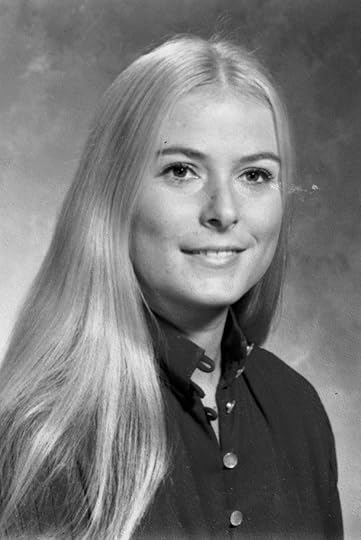
 Tom was excited. “The ship is coming into San Francisco the day after tomorrow but instead of only one day, we’ll be in dry dock for about a week!” He asked if I would drive up to the Bay area and spend the Holiday with him.
Tom was excited. “The ship is coming into San Francisco the day after tomorrow but instead of only one day, we’ll be in dry dock for about a week!” He asked if I would drive up to the Bay area and spend the Holiday with him.
Of course, I said yes! “I’ll be on the road first thing on the 24th,” I promised. “I’ll see you on Christmas Eve.”
The next morning, I visited my parents to let them know I would be gone over Christmas. My mother’s main objection was that she would worry if I drove my Volkswagen microbus. Though only four years old, it had seen many thousands of miles. “Why don’t you take my Karmann Ghia,” she offered. “It’s got fewer miles, and it will make the eight hour drive easier and quicker.” I accepted her offer, not because I was worried about the safety of my van, but because I thought driving her little sports car would be fun.
Christmas Eve morning, I set off. On Tom’s advice, I took the newly completed Interstate 5 now linking L.A and San Francisco through the farm country of the California Central Valley. It would be much quicker than the old Hwy 101 and I expected to arrive in Tom’s arms before dark.
Somewhere in late afternoon, about 2 and a half hours south of the Bay Area, I heard an explosive sound from the rear of the Ghia. With all power lost, I pulled to the side of the road. I was surrounded on all sides by flat farmland stretching off to the horizon. Because the highway was so new, there were few off-ramps or gas services.
Now remember, this was 1969. I did not have a credit card or a cell-phone. I did have an Auto Club membership card and, as it turned out, a savior. A middle-aged gentleman had pulled up behind me and stopped. He had seen a puff of smoke shoot from the rear of my car and stopped to offer help. With the lack of fear many of us still had in the 60s, I accepted his offer of a lift into the nearest town to call a tow-truck and locate a Volkswagen dealer. Luckily both were easy to find. I arranged for my mother’s car to be towed to the VW dealership parking lot and I left a note for the service department on the wind-shield. Now, I needed to get to Tom.
I asked my new friend if he would give me a lift to a nearby small, district airport. I hoped to find a car to rent but, when we got there, the terminal was totally dark and closed down. My new friend, who was heading for Walnut Creek (just north and east of Oakland), offered to take me as far as the Oakland Bay Bridge. He dropped me long after dark on the east side of bridge. There, I was able to find a taxi to take me across the bay and to the maritime dry-dock.
Imagine a worried Tom, striding back and forth near the shipyard gate, looking into the darkness and hoping that his girl-friend wasn’t lost or in an accident along the new, deserted Interstate. Now enjoy his surprise as I exit from a taxi with my overnight bag.
Tom, on the advice of one of his shipmates, had booked us a motel room in Daly City, a place close to the shipyard but far from the delights of San Francisco. The hotel was also far from romantic. Plain and drab, it did have a surprise feature – a coin-operated, vibrating bed. We fell onto the mattress and fed the bed quarters.
The next day was December 25. We rented a car and drove into San Francisco to look for Christmas dinner. From past experience in the city, we had reason to anticipate celebrating with a gourmet meal. We tramped the hills of Little Italy and Market Street in the Financial District. Every restaurant we passed was closed. After hours of searching, we found Lefty O’Doul’s. Mainly a bar, for this special night they offered a steam table buffet. Tom and I supped on roast turkey, dry from hours under the heat lamp, accompanied by soggy stuffing and tasteless gravy.
For the next few days, we dealt with the issue of my mother’s car. This included a full day to drive south to pick it up and finally return the rental car. Happy to have the Karmann Ghia to drive the hills of San Francisco, we spent much of the twenty-ninth enjoying Golden Gate Park and the rocky edge of the Pacific Ocean. On our way back to Daly City for an afternoon nap on the vibrating fingers bed, Tom heard a strange and unpleasant noise from the Ghia’s engine. He insisted on stopping by the Volkswagen dealer only a few blocks from the motel. Next thing I knew, my mother’s car was again in line for a major repair. The service manager promised me it would be ready on the morning of December 31.
The next morning Tom’s ship sailed out under the Golden Gate Bridge. I was left all alone with the vibrating bed, a bucket of fried Chicken, and the beginnings of a cold.
You would be within reason to assume that my drive home would be without incident. I certainly couldn’t wait to crawl into my own bed, back in Laguna Beach.
Nursing my evolving cold, I entered the traffic of Los Angeles at dusk on New Year’s Eve. I chose to take the new Interstate 5 route that ran close to Griffith Park, behind the new Dodger Stadium, and near Chavez Ravine. That year, on the evening of December 31, this historic Hispanic neighborhood suffered a devastating mud-slide. Tons of earth slid down the hill, carrying houses with it, and engulfed the nearby Interstate.
The highway was closed. The California Highway Patrol redirected all the growing New Year’s Eve traffic, myself and my little sports car included, to the old Hollywood Freeway. Everyone seemed in a hurry to get somewhere, rushing forward when lanes were open, then screeching to a stop as jams inevitably occurred.
It happened very fast. I saw the red lights up ahead and put on my brakes. I had plenty of room to stop. Suddenly a pickup truck without enough space in his own lane veered in front of me. Still, I stopped just short of tapping his bumper. Then CRASH! A car smashed into my rear-ended with enough force to ram the Ghia into the truck. I was sandwiched between two other vehicles. Luckily, I seemed to be uninjured. As I assessed my limbs and my situation, the traffic ahead opened for a moment. Without hesitation, the truck that had caused the accident sped off, leaving a track of rubber in his wake.
There were police to convince that I hadn’t caused the crash. There was the need to get my Mother’s car towed again. And luckily there was another savior. This time a young man about my own age who, finding himself alone on New Year’s Eve, offered to drive an unknown, young blond to her home 60 miles away. I’m afraid he did not receive much of a reward beyond a cup of hot tea and a wave good-bye.
After this experience, I can enjoy a small, quiet Holiday like we will have this year. I am thankful that I will share the Holidays with my daughter and my partner, Ron, and I look forward to a zoom gathering with my family. All our friends and family are well, we are sheltered in place around a decorated tree, and we have a duck for our Christmas table. For 2020, it is more than enough.
Happy Holidays! Merry Christmas! Season’s Greetings! Hanukkah Sameach!
¡Feliz Navidad! Kwanzaa yenu iwe na heri!
The post Memories of Christmas Past or, So You Think this Holiday Season is Sad? appeared first on Klang Slattery.
December 3, 2020
Books for the Armchair Traveler
In early January of 2017, when I sat down at my computer to begin my memoir, I knew it would be of interest to armchair travelers. But I never imagined, as I typed the first words of the first chapter, that the book would be released in the middle of a pandemic when travel was limited. Now many who would otherwise be roaming the globe are stuck at home.
The AAA membership magazine Westways (September /October 2020) featured an article titled “Transported by Armchair.” The authors, Paul Lasley and Elizabeth Harryman, state, “Vicarious adventures can get us through tough times.” They point out that would-be travelers can adventure vicariously through movies, books, magazines, and on the internet.
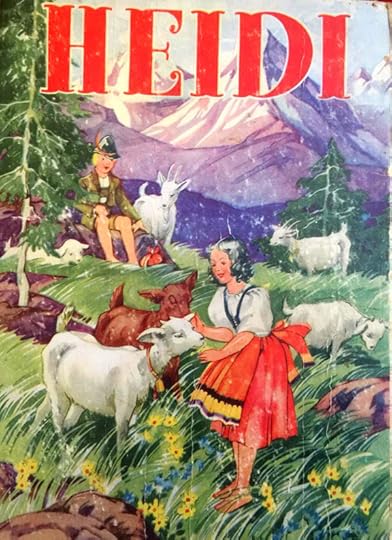 I have always loved books and movies that take me to foreign places. Everything, from my favorite childhood book, Heidi, to the 2014 movie The Hundred Foot Journey about Indian food in a French village, has inspired my fascination with travel. While I was still in high-school, my father took me to see The World of Apu, an acclaimed Bengali film that introduced me to an exotic land, an entirely different way of life, and the music of Ravi Shankar. My interest in China was sparked, at about the same time, when I read Pearl S. Buck’s Pulitzer Prize winning novel, The Good Earth. A love of all things European, an integral part of growing up with an immigrant father, accelerated during my first trip to Europe at the age of 17.
I have always loved books and movies that take me to foreign places. Everything, from my favorite childhood book, Heidi, to the 2014 movie The Hundred Foot Journey about Indian food in a French village, has inspired my fascination with travel. While I was still in high-school, my father took me to see The World of Apu, an acclaimed Bengali film that introduced me to an exotic land, an entirely different way of life, and the music of Ravi Shankar. My interest in China was sparked, at about the same time, when I read Pearl S. Buck’s Pulitzer Prize winning novel, The Good Earth. A love of all things European, an integral part of growing up with an immigrant father, accelerated during my first trip to Europe at the age of 17.
Since my earliest years, I have preferred books and movies that take me to distant lands and times. They were the beginning of my wanderlust and, to this day, I am drawn to them over contemporary stories in US settings.
The process of writing and editing my travel memoir allowed me to relive the experience of a lifetime. Luckily, I have a treasure-trove of memory enhancers to lead me back in time. During the two years on the road, I wrote seventy-three journal-style letters home and dozens of postcards to friends and relatives, all with the request to keep them safe till my return. To this day, I have those letters, most still accompanied by their stamped envelopes. The handwritten letters on thin airmail paper often included sketches in the margins. As I reread my words from 50 years ago, pored over saved travel books and maps, and viewed long-unseen slides, I rediscovered forgotten incidents that sparked memories as fresh as the day they happened.
Now I have the joy of holding in my hands a copy of the finished book that tells the story of the best days of my life. When I pick it up and allow the pages to fall open where they will, I am greeted by words that take me back to those days when love was new and the world we traveled was a different place.
******************************
Travels with Charlie meets Eat, Pray, Love. Mash these two well-known memoirs together and Voila! Wherever the Road Leads. This movingly honest memoir tells the story of two lovers on a dream adventure in the early 1970s. The personal saga of a two-year long, 40,000 mile, international road trip in a VW van, Wherever the Road Leads describes culinary adventures, the inspiration of art and history, and lovemaking under the stars. A pair of newlyweds (an artist and an engineer) meet the rigors of travel that includes an overland journey to India in a time before the internet or cell phones. Each day brings challenges as the young couple experience the ups and downs of married life in a Volkswagen microbus that continually needs repair. Everything, from engine problems to personal sanitation, from running out of funds to primitive roads, affects their journey. Will their relationship thrive or will it crumble under the pressure of living together 24/7 in a van?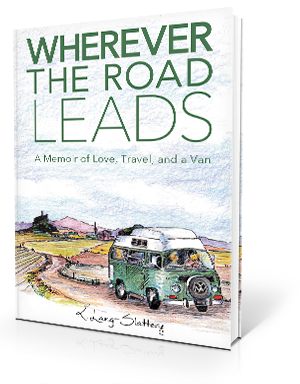
As we spend more time at home during this year of Covid, we are all becoming armchair travelers. What books and movies have substituted for an actual journey for you? Do travel stories comfort you or make you long to get on the road again? Or both?
Here are 8 of my favorite travel memoirs. Several of them (with the *) also feature recipes.
Paris Letters, by Janice MacLeod
Without Reservations, by Alice Steinbach
A Pig in Provence, by Georgeanne Brennan*
West of Kabul, East of New York, by Tamim Ansary
Little Princes, by Connor Grennan
Apples Are from Kazakhstan: The Land that Disappeared, by Christopher Robbins
Lunch in Paris, by Elizabeth Bard*
An Embarrassment of Mangoes, by Ann Vanderhoof*
For interesting lists of travel books, check these two sites:
https://www.businessinsider.com/best-travel-books
Armchair Travel Books to Transport You to a New Destination | Condé Nast Traveler (cntraveler.com)
The post Books for the Armchair Traveler appeared first on Klang Slattery.



